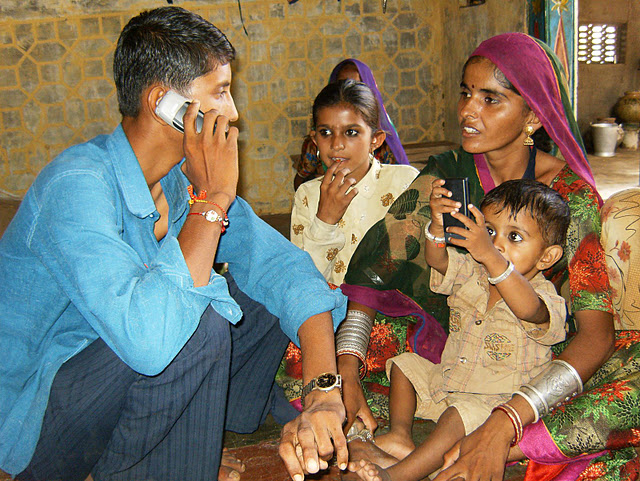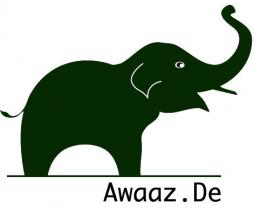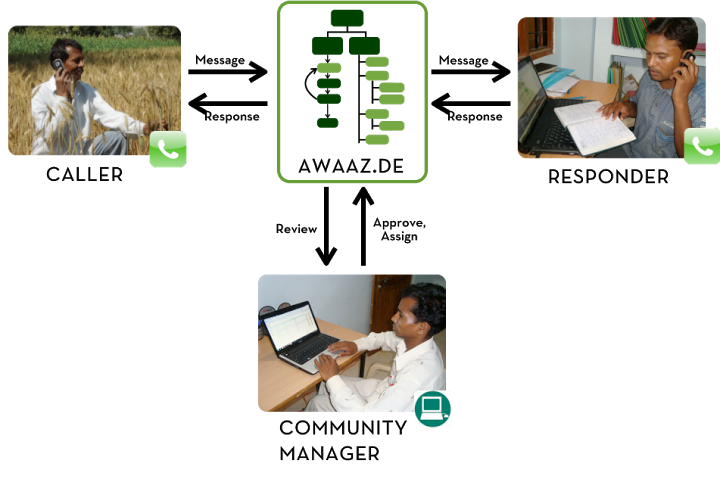Awaaz.De (“Give your voice”) is a software platform enabling organizations to engage with poor, remote, and marginal communities by providing on-demand, many-to-many information access through mobile phones. People access Awaaz.De applications by dialing regular phone numbers to create, browse, and share voice content through automated voice interfaces. Voice makes it easy to provide services in local languages, overcomes literacy constraints, and offers a low barrier to content creation: one only needs to know how to speak into a phone. Organizations use Awaaz.De to host voice-based information portals, discussion forums, Q&A services, classifieds, and more. For example, rural development organizations can offer demand-driven agricultural extension through a farmer Q&A service, broadcast market prices and weather reports targeted by crop and location, or perform real-time data collection on availability of farm inputs and outputs. In this way, Awaaz.De helps organizations reach previously disconnected people with on-demand, locally relevant information, in their language. Most importantly, Awaaz.De is a social platform that supports people to give their own voice and participate not just as passive consumers, but active producers of knowledge.
create, browse, and share voice content through automated voice interfaces. Voice makes it easy to provide services in local languages, overcomes literacy constraints, and offers a low barrier to content creation: one only needs to know how to speak into a phone. Organizations use Awaaz.De to host voice-based information portals, discussion forums, Q&A services, classifieds, and more. For example, rural development organizations can offer demand-driven agricultural extension through a farmer Q&A service, broadcast market prices and weather reports targeted by crop and location, or perform real-time data collection on availability of farm inputs and outputs. In this way, Awaaz.De helps organizations reach previously disconnected people with on-demand, locally relevant information, in their language. Most importantly, Awaaz.De is a social platform that supports people to give their own voice and participate not just as passive consumers, but active producers of knowledge.
Currently Awaaz.De serves eight social development organizations and enterprises across six states in India working in agriculture, education, women’s empowerment, labor rights, and rural products. These organizations serve as content providers, and use Awaaz.De to disseminate their informational content in real time, as well as collect input from the community through interactive features. These organizations have proven the value of Awaaz.De through willingness to pay; partners pay a recurring monthly fee to host their customized voice information service with Awaaz.De
The other demonstration of Awaaz.De’s value comes through the response from the communities of users. To date, Awaaz.De has served over 100,000 calls from over 10,000 unique callers. People rate content highly whenever ratings are solicited; in one deployment, the average rating was 2.8/3 from 325 individual ratings. A bit more anecdotally, unsolicited messages of praise and gratitude come in regularly from people. In a study where an Awaaz.De partner sent agricultural information broadcasts to farmers and then prompted for a question or comment, 37% of the recordings posted were simply comments of praise for the service, compared to 41% posts asking technical agricultural questions. To us, these are small indicators of Awaaz.De's potential for not only building knowledge capital, but social capital. Here’s another good anecdotal example.


 end-users access content through regular phone numbers. After calling in, they navigate automated message boards with touchtone to create, browse, and respond to voice messages posted by others. A “personal inbox” option plays the caller’s own messages, identified by their phone number. Message boards are configured with a number of policy settings. A message board can be listen or post-only, moderated, and allow community response. It can also define sub-message boards based on hierarchical categories. Awaaz.De’s second component is a web interface that lets community managers moderate the voice forums, annotate and categorize content, route messages to specific experts for responding, conduct voice-based surveys, collect ratings, and broadcast the best content to wide (e.g. last 1,000 callers) or targeted (e.g. all callers who have posted messages related to wheat) audiences. Taken together, the two components of Awaaz.De provide an “Internet for the few, voice for the many” model, where the mostly Internet-less community members access content and communicate through mobile voice interfaces, and community managers with access to the Internet administer the system through the web interface.
end-users access content through regular phone numbers. After calling in, they navigate automated message boards with touchtone to create, browse, and respond to voice messages posted by others. A “personal inbox” option plays the caller’s own messages, identified by their phone number. Message boards are configured with a number of policy settings. A message board can be listen or post-only, moderated, and allow community response. It can also define sub-message boards based on hierarchical categories. Awaaz.De’s second component is a web interface that lets community managers moderate the voice forums, annotate and categorize content, route messages to specific experts for responding, conduct voice-based surveys, collect ratings, and broadcast the best content to wide (e.g. last 1,000 callers) or targeted (e.g. all callers who have posted messages related to wheat) audiences. Taken together, the two components of Awaaz.De provide an “Internet for the few, voice for the many” model, where the mostly Internet-less community members access content and communicate through mobile voice interfaces, and community managers with access to the Internet administer the system through the web interface.

